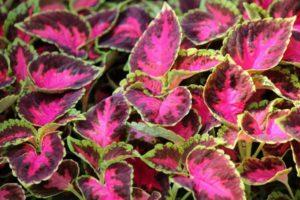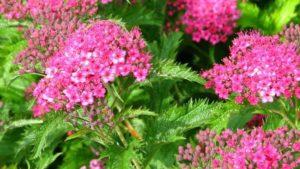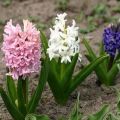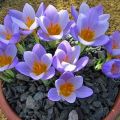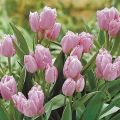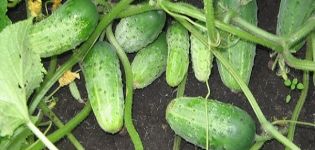Planting and caring for freesia at home, how to grow from a bulb
Florists love to discover new exotic cultures. Each of them, in the process of his lesson, gets acquainted with such a flower as freesia. It often grows outdoors, but can be planted indoors. As practice shows, freesia is a capricious flower. Therefore, when growing freesia at home, it is necessary to make a lot of effort so that no difficulties arise during planting and care.
Description of a delicate flower
The average height of a houseplant is 55-65 cm. The shoots are decorated with green leaves. In length, leaf plates reach 20 cm, and in width - 2 cm. From 7 to 12 flowers appear on one inflorescence. The flowers reach 6 cm in diameter. In color, they are white, yellow, purple, lilac and red. The flowers give off a delicate scent reminiscent of a mixture of lily of the valley and lily.
Freesia varieties
Most often in the "possessions" of flower growers there is a hybrid. It is the result of crossing Armstrong's freesia and refracted freesia. The listed types are the most basic.
Freesia Armstrong
The bush reaches a height of 60-70 cm. It blooms with pink, scarlet or red flowers. They resemble bells in shape. On each panicle, from 3 to 5 pieces are formed. The green leaves look like small swords due to their elongated shape. Blooms in May. The most common variety of this type of freesia is Cardinal.
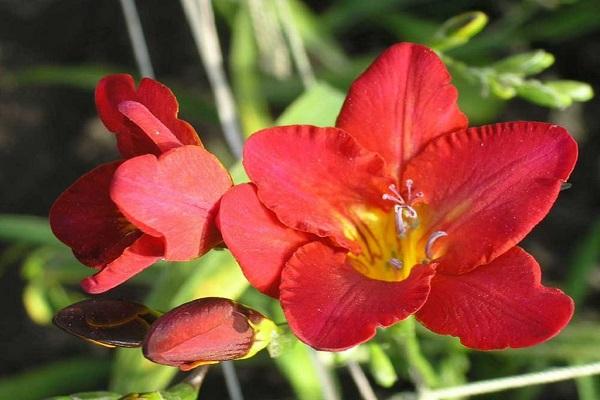
White, bruised or refracted
Unlike other types, it has a compact size. The bush does not grow higher than 40 cm. Thin stems form a sprawling bush. Bloom begins in April. Refracted varieties: Alba and Fragrant.
Freesia hybrid
The flower species received the best qualities from its parents. The tall shrub is characterized by strong branching. On the brushes, large flowers grow, emitting a delicate aroma. They come in different monochromatic colors, and are also painted in several shades at once. Popular subspecies: Rose Marie, Ballerina and Pimperina.

Features of growing at home
Freesia is a fragrant flower that has adapted well to indoor cultivation. As a rule, people celebrate its flowering in winter, but not everyone knows how to plant freesia in a pot. There are general requirements for all types.
Freesia needs
Despite the fact that the flower pot is under the supervision of a person, it requires increased attention.Having created all the necessary conditions, you can achieve abundant flowering.
Shine
The flower loves a lot of light and, unfortunately, in the cold season, the weather is not able to provide this. Freesia should be kept under light for at least 12 hours a day. The most suitable place in the house for a flower is the windowsill, located on the south side of the house. But at the time of increased solar activity, the plant is removed away from direct rays.
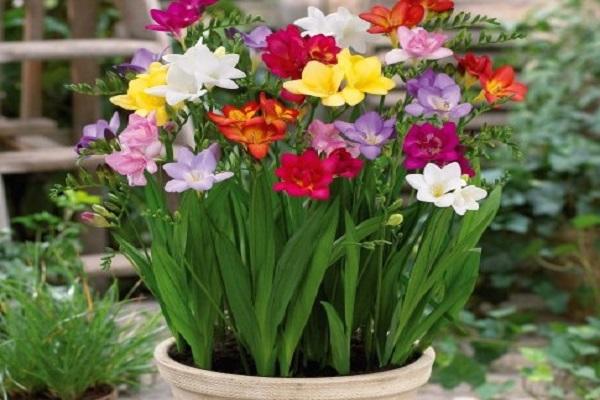
The soil
Most gardeners buy a ready-made earthen mixture for a flower. The recipe for preparing the substrate is very simple, so anyone can do it. For a container, you will need earth from under any tree (leaf), sand and peat. So that the culture does not need calcium, the soil is enriched with ash and bone meal. The last components are taken on a pinch, as this will be enough.
Temperature
When planting a plant in the spring, it is necessary to keep the temperature within 20 ° C indoors. If the planting was carried out in winter, the first two weeks they keep the same temperature as in the previous case. After that, it is lowered to 10 ° C. The plant does not tolerate sudden temperature fluctuations.
If the thermometer shows below 2 ° C or above 20 ° C, the crop shoots will be deformed. She will grow and develop poorly.
Moisture
The humidity level in the room where the flower grows should be medium. It is recommended to avoid high humidity as it negatively affects the flower. Dry air also does not benefit freesia.
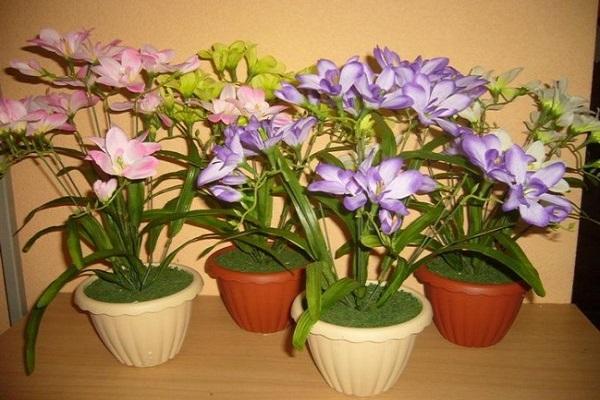
Support
Long freesia leaves are tied to the support. If this is not done, they dangle and break over time. As a result, this spoils the appearance of the bush.
At the time of bud formation, the stems must also be tied up. For this, a support is used. The strength of the plant is not enough, especially if the culture is large and blooms profusely. The flowering period lasts 1 month.
Further care for freesia
If you plant a flower according to all the rules, this still does not guarantee favorable growth. In order for a culture to develop fully, it needs careful care. Freesia needs watering, fertilization, replanting and even preparation for winter.
Features of watering before and during flowering
The flower reacts very strongly to water quality. To avoid any problems, they take exclusively settled water. Water the soil twice a week as it dries. It is enough to moisten the top layer.
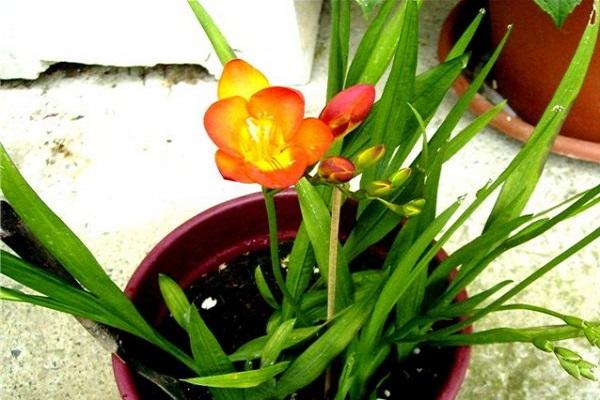
In winter, the air is dry enough, so the plant may need moisture. For this, freesia is sprayed from a spray bottle. The procedure is recommended in the evening.
In the shops that sell flowers, there are various devices for humidifying the air. Most often these are small fountains. If possible, it is placed near the flowerpots. During flowering, the crop needs a lot of moisture. Watering will decrease over time.
How to fertilize a flower correctly
Ideal for freesia - mineral fertilizers twice a month. It can also be complexes designed specifically for flowering plants. 2 weeks after the cessation of flowering, the soil continues to be saturated with superphosphate.
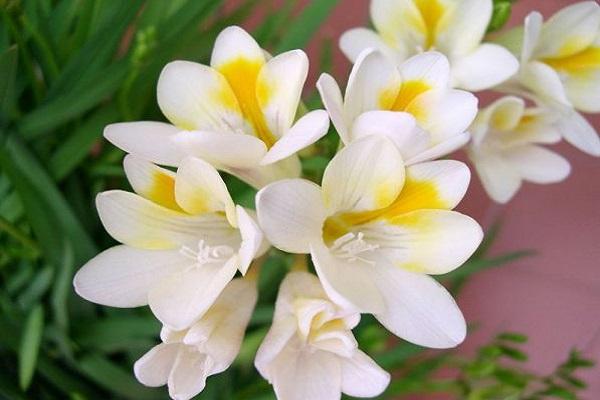
The specifics of leaving after flowering
It is necessary to take care of the plant after the flowers disappear. It is not customary to leave faded inflorescences on the shoots, they get rid of them. Also remove the leaf plates and stems to the very base. Only the onion remains in the container.
Watering is not stopped for 8 weeks. After that, it is dug out of the soil and cleaned to remove excess soil. The bulbs are placed in water with the addition of potassium permanganate. This is a mandatory procedure for every instance. After soaking, they should dry out within 3-4 days.
Plant transplant
The hybrid species requires an annual transplant.The procedure is carried out in the spring. For everything to go well, the container with the flower is kept in a room with a temperature of no higher than 15 ° C. Thanks to this approach, the culture gives its first shoots 2-3 weeks after transplanting to a new place.
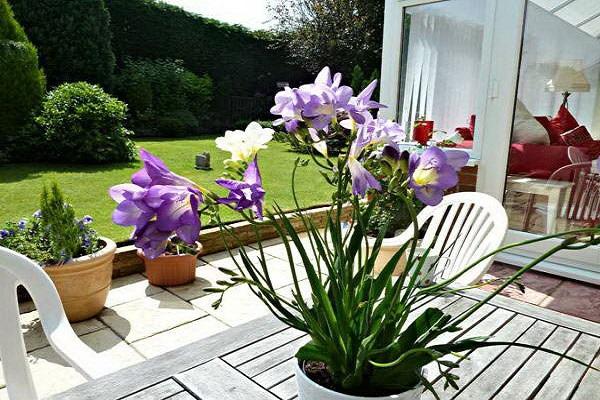
Breeding methods
The flower propagates in two ways:
- seeds;
- bulbs.
Collected or purchased grains are sown in loose soil with the addition of peat. Sowing is carried out in late March or early April. After the appearance of young shoots, the culture gradually develops, and flowering occurs in the fall.
Reproduction of freesia by bulbs means planting it in the ground to a depth of 5-6 cm. They are planted in spring in April. Freesia is a flower that multiplies easily. Therefore, you can engage in her breeding and planting all year round.

Storing the bulbs
Despite indoor cultivation, freesia needs a summer or winter break, depending on what time it bloomed. If the plant is young and has only had one growing season, it is not disturbed until the next season. The container is taken out to a cool place and kept there until the next season. The room temperature must be dry.
Freesia bulbs are stored outside the soil. The pot is freed from the ground, and they are sorted, choosing large and small. Small ones are separated from large ones, which managed to form during the growing season.

Bulbs are stored in the same way as ordinary onions harvested for the winter. In no case do you choose a refrigerator for this. Frequent fluctuations in humidity and temperature contribute to the awakening of the bulbs.
If this happened once, there is nothing wrong with that and the bulbs will not suffer from this. But if this phenomenon is repeated constantly, the plant may not bloom. Failures of this kind are harmful to culture.
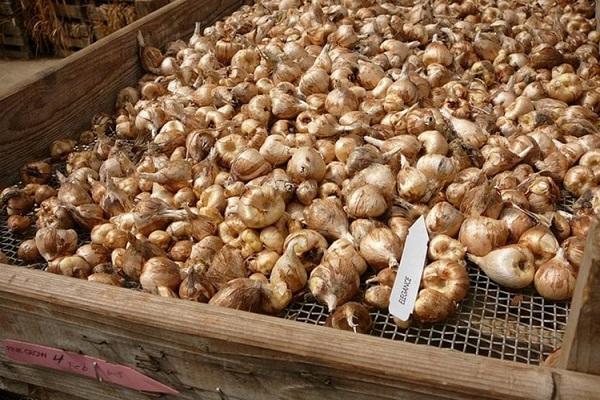
Freesia is stored in such a place that it is protected from moisture. Otherwise, it can cause rot. Rodents are very fond of rodents, so the bulbs also have to be protected from them.
Growing freesia in an onion pot is quite possible. The main thing is to approach this matter with all responsibility. As a result, a person will receive a beautiful flowering plant that will decorate the room and bring bright colors to cold winter days.
